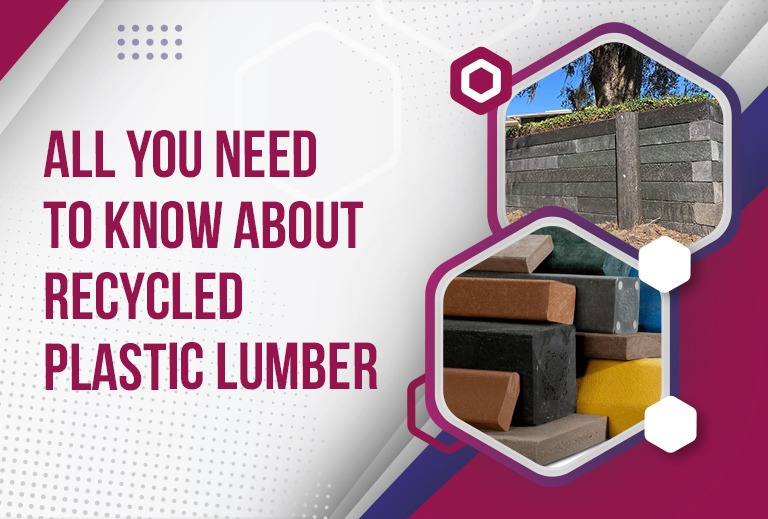All You Need To Know About Recycled Plastic Lumber
For many years, wood was the preferred choice for structural components. However, due to their natural origins, wood-based products have certain structural defects, like low-dimensional stability, fungal damage, wormholes, warping, cracks, knots and some other imperfections that result from drying and varied moisture content.
These defects have a huge impact on the overall strength of the product and are not easy to manage. This has led many businesses to look for alternatives that can stand the test of time. An alternative that best matches natural wood is recycled plastic lumber.
Recycled plastic lumber has one important benefit – it is environmentally friendly. Apart from this one notable benefit, recycled plastic lumber is also beneficial for the community. This form of plastic has been creating work and business opportunities. It saves more money for local governments because of the low long-term maintenance costs.
What are the different types of recycled plastic lumber?
- Commingled limber: This recycled lumber is created with recovered thermoplastic, which can be re-melted and remoulded into any form of end-product. Commingled lumber has 80-90% polyethylene. This one is economical and suitable for landscaping solutions.
- High-density Polyethylene: This type has 95% HDPE, which is the material used to make plastic milk jugs and is suitable for decking and landscape solutions. It is available in various colours and looks aesthetically good. This eliminates painting costs. When it comes to measuring stiffness, it is not as stiff as wood. It’s a good option for perennial landscaping solutions.
- Fibre-Reinforced lumber: It is a mixture of chopped/continuous glass fibre strands and recycled plastic. Fibre-Reinforced lumber is firm and therefore is used to build support structures. It is used for high density polyethylene plastic fencing and playground equipment.
- Wood-Filled lumber: This type is a mix of sawdust and recycled plastic. This plastic can be combined with more recycled fibres and has 50% polyethylene. It has good surface roughness, few voids and superior traction. It is best for high density polyethylene plastic fencing.
What are the advantages of recycled plastic lumber?
- Long-lasting durability: Recycled plastic lumber is nonporous, chemical-resistant and water-resistant. These properties make it durable. Resistance to graffiti and insects make it suitable for fencing systems. This form of plastic is good to create playground equipment since it does not splinter.
- Environment-friendliness: Recycled plastic is environment-friendly. Plastic is moved from landfills to make it usable and thus help in maintaining environmental balance.
- Economic advantages: When compared to wood lumber or timber, recycled plastic is much more economical. However, the purchase price may be higher if maintenance, disposal, replacement and installation is considered. You can save a lot of money with recycled plastic lumber.
- Easy maintenance: It is frustrating, costly and challenging to maintain natural wood-based products. However, recycled plastic wood needs zero to minimal maintenance. Recycled plastic wood is “pre-coloured” and therefore requires no staining or painting.
Need more information about recycled plastic lumber? Be a part of Plastivision 2023 (December 7-11) and explore the new offerings that will be on display. The event will be held at the Bombay Exhibition Centre, Mumbai. This is your opportunity to network with some of the finest minds in the industry. See you there at the event!
Leave a Reply Cancel reply
Recent Posts
- Understanding The Materials That Are Used To Build Plastic Toys
- All You Need To Know About Food-grade Plastics
- A Glance At The Materials That Boost The Performance Of Plastics
- Understanding The Importance Of Exploring New Business Opportunities In The Plastic Industry
- Understanding The Importance Of Investing in R&D For The Plastic Industry
Categories
- 3D Printing
- AIPMA
- Automation
- Automobile Sector
- Bio Plastics
- Environment
- Innovations In Recycling
- Latest Innovations
- Molds & Dies
- News
- Packaging Industry
- Plastic
- Plastic Application
- Plastic Industry
- Plastic Market
- Plastic Myths
- Plastic News From The World
- Plastic Packaging
- Plastic Products
- Plastic Recycling
- Plastic Solar Cells
- Plastic Toys
- Plastic Waste
- Plastic World
- Plastics
- Plastics And Their Applications
- Plastics In Agriculture
- Plastics In Healthcare
- Plastics In Medical Industry
- Plasticulture
- Processing Machinery
- Recycling Machines
- Robotics
- Uncategorized
- Virtual Reality
Archives
- November 2023 (3)
- October 2023 (2)
- September 2023 (3)
- August 2023 (3)
- July 2023 (3)
- June 2023 (3)
- May 2023 (2)
- April 2023 (2)
- March 2023 (2)
- February 2023 (2)
- January 2023 (2)
- December 2022 (3)
- November 2022 (1)
- October 2022 (1)
- September 2022 (2)
- August 2022 (1)
- July 2022 (3)
- May 2022 (3)
- March 2022 (2)
- February 2022 (1)
- January 2022 (1)
- September 2021 (2)
- August 2021 (3)
- July 2021 (4)
- June 2021 (4)
- May 2021 (3)
- April 2021 (2)
- March 2021 (4)
- November 2019 (8)
- October 2019 (8)
- September 2019 (8)
- August 2019 (8)
- July 2019 (8)
- June 2019 (8)
- May 2019 (8)
- April 2019 (8)
- March 2019 (8)
- February 2019 (11)
- January 2019 (8)
- December 2018 (8)
- November 2018 (12)
- October 2018 (12)

